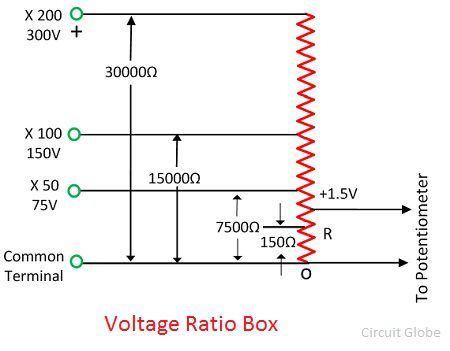Definition: The volt-ratio box measures the high voltage. The construction of the volt-ratio box is very simple. It consists the simple resistive potential divider which has many tapping on the input side. The whole arrangement of the volt-ratio box is placed inside the wooden box. The volt-ratio box gives the accurate result of measure voltage.
The operation of the volt-ratio box is simple. The volt-ratio box uses for measuring the voltage having the value higher than 1.8 volts. It is also used for step down the high voltage for measurement.
The arrangement of the volt-ratio box is shown in the figure below. The voltage marked on the internal tapping of the volt-ratio box along with the multiplying factor of the potential scale. The electromotive force which is to be measured is applied to the input terminals of the volt-ratio box. The potential difference between the two points is measured through the potentiometer.
 Consider the voltage measured by the potentiometer is v and the multiplying factor of the voltage ratio box is k then the value of the measured voltage is V = v.k volt.
Consider the voltage measured by the potentiometer is v and the multiplying factor of the voltage ratio box is k then the value of the measured voltage is V = v.k volt.
Example – Consider the voltage to be measured is applied to the terminal of the voltage ratio box. The potentiometer reads the value of 0.825. The value of the unknown voltage is measured through the formula.
V = 0.825 X (300/1.5) = 165 volts.
During the high voltage measurement, the current passes through the resistance R shown in the figure above. The voltage drop occurs across the resistance in the measurement of the high voltage. The resistance act as a load on the measurand voltage source and hence consume power. The resistance of high value is used in the volt-ratio box for low power consumption.
Usually, the resistance of 100 Ω/volt or 200 Ω/volt is used in the volt-ratio box which allows maximum 5 to10 mA current to pass through it.
Note: The multiplying factor in the volt-ratio box shows the number of times the value of the voltage increases.
